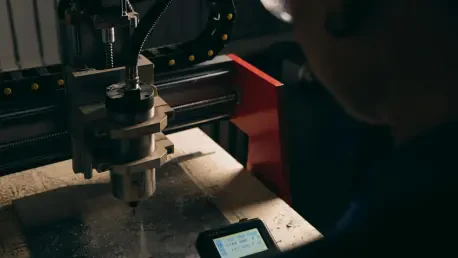In an era where digital transformation dictates the pace of progress, Intelligent Process Automation (IPA) stands out as a revolutionary force reshaping the very foundation of business operations across the globe. By seamlessly integrating artificial intelligence (AI), machine learning (ML), and robotic process automation (RPA), IPA offers a robust framework for companies to enhance efficiency, minimize costs, and streamline complex workflows in industries ranging from banking and healthcare to retail and manufacturing. The market’s explosive growth, valued at USD 14.12 billion in 2024 and projected to soar to USD 63.60 billion by 2032 with a compound annual growth rate (CAGR) of 20.61%, underscores the urgent demand for such technologies. This remarkable trajectory highlights how businesses are increasingly turning to automation not just for survival but to gain a competitive edge. As IPA continues to evolve, it promises to redefine operational models, making agility and innovation accessible to enterprises of all sizes, setting the stage for a profound shift in the corporate landscape.
Fueling Efficiency Through Key Drivers
The adoption of IPA is being propelled by a compelling need for cost reduction and operational efficiency, a priority shared by both public and private sectors worldwide. Government initiatives serve as a prime example, with the UK identifying over 140 AI use cases this year to enhance public sector productivity, resulting in a remarkable 40% reduction in administrative burdens for tasks like policy drafting. Such efforts demonstrate the transformative power of automation in handling repetitive, time-intensive processes, freeing up resources for more strategic endeavors. Beyond government, the private sector is equally invested, particularly in IT operations, which alone accounted for a market value of USD 4.22 billion in 2024. By leveraging IPA, companies are optimizing system monitoring and incident response, significantly reducing downtime and enhancing service reliability. This dual push from public and private spheres illustrates the broad applicability of IPA as a tool for achieving measurable efficiency gains.
Another critical driver lies in the growing recognition of IPA as a catalyst for digital transformation across diverse industries. Businesses in sectors like Banking, Financial Services, and Insurance (BFSI), as well as healthcare, are increasingly deploying these solutions to automate routine tasks while sharpening decision-making capabilities through AI and ML integration. This not only cuts operational costs but also improves customer experiences by enabling faster, more accurate service delivery. Unlike traditional automation, IPA goes beyond mere task execution to offer predictive insights, allowing firms to anticipate challenges and adapt proactively. The momentum is further fueled by the scalability of these technologies, which can be tailored to meet the unique needs of small enterprises and global corporations alike. As more organizations witness tangible benefits, the drive to adopt IPA intensifies, positioning it as an indispensable component of modern business strategy.
Redefining Operations with Hyperautomation
Hyperautomation represents a groundbreaking facet of IPA, where multiple technologies converge to create seamless, end-to-end automated systems that drastically reduce human intervention. This approach integrates AI, RPA, and advanced analytics to manage entire workflows, enhancing speed and flexibility in ways previously unimaginable. A notable example is the launch of ABB’s OmniCore robotics control platform in 2024, which combines AI, sensors, and cloud computing to deliver unparalleled precision and operational efficiency. Such innovations highlight how hyperautomation within IPA can transform complex processes, enabling businesses to respond swiftly to market changes. The ability to connect disparate systems into a cohesive framework marks a significant leap forward, offering companies a pathway to not just keep up but to lead in their respective fields through smarter, faster operations.
The implications of hyperautomation extend beyond technical advancements to fundamentally alter how enterprises approach scalability and innovation. By automating intricate processes from start to finish, businesses can allocate human resources to higher-value activities such as strategic planning and creative problem-solving, fostering a culture of continuous improvement. This shift also minimizes errors inherent in manual processes, ensuring consistency and reliability in outputs, which is particularly vital in industries like manufacturing and healthcare where precision is paramount. Furthermore, hyperautomation paves the way for real-time data analysis, empowering organizations to make informed decisions on the fly. As this trend gains traction, it becomes clear that IPA’s role in driving hyperautomation is not merely about efficiency but about reimagining the potential of business operations to achieve sustainable growth in a competitive landscape.
Market Leadership and Regional Dynamics
The solution segment of IPA, valued at USD 8.78 billion in 2024, continues to lead the market by offering comprehensive tools that automate workflows end-to-end, slashing manual errors and boosting scalability. These solutions stand out for their ability to integrate seamlessly into existing systems, providing businesses with faster turnaround times and improved operational coherence. Unlike standalone tools, IPA solutions address the entirety of a process, ensuring that every step—from data entry to decision-making—is optimized for performance. This dominance reflects a broader industry consensus on the value of holistic automation, particularly for enterprises aiming to modernize without overhauling their infrastructure. As demand for such tools grows, the solution segment is poised to remain a cornerstone of IPA’s transformative impact on business efficiency.
Regionally, North America holds the largest share of the IPA market at 34.09% in 2024, driven by aggressive business modernization and strategic partnerships that expand automation capabilities. Meanwhile, Asia Pacific emerges as the fastest-growing region with a projected CAGR of 21.73% over the coming years, fueled by industrial automation and the rapid adoption of AI in manufacturing hubs. The convergence of technological investment and industrial growth in Asia Pacific, alongside North America’s focus on innovation through acquisitions, paints a dynamic picture of global IPA expansion. These regional trends underscore the varied yet interconnected ways in which automation is being embraced, with each area leveraging its unique strengths to harness the benefits of IPA. Together, they highlight a worldwide shift toward smarter, more automated business practices.
Competitive Innovation and Future Outlook
The competitive landscape of IPA is marked by relentless innovation, as industry giants like IBM, Accenture, and Genpact pursue strategies such as acquisitions, product launches, and collaborations to strengthen their market foothold. These efforts are not merely about expansion but about creating integrated platforms that meet the evolving demands of businesses across sectors. The focus on comprehensive solutions aligns with the industry’s shift toward hyperautomation, ensuring that automation tools are not siloed but part of a broader, interconnected ecosystem. This competitive drive fosters a cycle of continuous improvement, pushing the boundaries of what IPA can achieve and setting new standards for operational excellence on a global scale.
Looking ahead, the strategic initiatives of these major players signal a future where IPA becomes even more embedded in business frameworks, reshaping how companies operate at every level. The emphasis on partnerships and technological integration suggests that the next phase of growth will prioritize adaptability, allowing firms to customize automation to their specific needs. As the market progresses toward a projected value of USD 63.60 billion by 2032, the lessons from past innovations and regional successes will guide the development of more sophisticated tools. Reflecting on the strides made, it’s evident that the journey of IPA has been one of remarkable transformation, with each advancement building toward a landscape where automation is not just an option but a fundamental driver of success.









